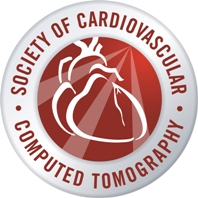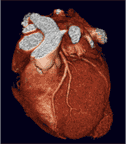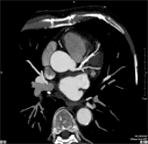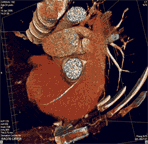These documents and videos may be helpful:
FREQUENTLY ASKED QUESTIONS
Prospective students with questions about the courses
- Why should I get certified now?
CCTA is a rapidly advancing field. Developments in chest pain assessment in the emergency room have recently increased the interest in CCTA Training by both radiologists and cardiologists. There is a need for qualified readers of CCTA. Another reason to get trained is that when the guidelines are issued for Peripheral Vascular Disease, they will allow you to fast-track your training if you are already Level 2 CTA trained.
Finally, cardiac imaging is in its infancy. Training now will allow you to be prepared for future modalities that will be derived from this technology. CT Perfusion is in development and being an established reader of CCTA will further your ability to quickly and accurately read both anatomy and perfusion deficits.
- I don’t know if I am going to go all the way to Level 2. What if I want to attend Level 1 classes and then decide?
You can complete Level 1 and then decide if you would like to continue to Level 2. Almost all of our students who have completed Level 1 decided to complete their studies to Level 2 after they have attended our class for a few days. The ACC deadline to be grandfathered in for certification is rapidly approaching. In addition, many hospitals and insurers are requiring Level 2 certification. Finally, in a competitive medical marketplace, being certified early can help enhance your practice’s services to the medical community.
- After I have completed my Level 1 training with you, do I have to use the software or can I choose to come back for live training?
You can attend the 3-day live part of the class and then decide if you prefer to finish via software or live training. The software provides a virtual simulation of our training environment and allows you to self-pace the completion of your certification. This equates to less time out of the clinic and away from family and saves on travel costs. If you prefer to come back to our center for live training, we regularly conduct a 4 day finisher course in our San Francisco center. However, space is limited.
- Do you offer CME credits?
Yes, you can earn as many as 64 CME credits if you complete your Level 2 accreditation with us. You will get CME credits for the live classes and the self-study coursework that you complete.
- What type of workstations do you teach on?
We teach courses on both Vital Images (Vitrea) and the TeraRecon workstations.
- I have a GE, Siemens or Phillips workstation. Can I come to one of your courses?
Yes, our workstation based course is designed to teach you a systematic approach to reading Cardiac CT. Developing a systematic approach and understanding Cardiac CT workflow is what we specialize in. It does not matter what workstation you learn this on, you can transfer the skills from Vital Images or TeraRecon to the GE, Siemens or Phillips workstations. We have trained many students who have purchased workstations other than Vital Images or TeraRecon.
- Do you recommend TeraRecon or Vital Images (Vitrea)?
Vital Images (Vitrea) and TeraRecon are both superb workstations. TeraRecon was an early leader in cardiac imaging, but now we see an almost equal interest in the workstations. TeraRecon appears to be strong in large hospital environments with their ThinClient Server, but now Vital Images also has a similar product. Both of these companies make a strong effort to distance themselves from the workstations made by the large manufacturers.
When colleagues ask us to compare the two products offered, we strongly recommend that they do their diligence on customer support and remote vs. local bandwidth needs. We recommend asking existing users about their experience, and even coming to a CTA training class to test drive the machine for a few days.
-
What type of CT machine do you use?
We have a Toshiba 64 slice, but Dr. DeFrance has experience with all of the 64 slice CT scanners and extensive experience on the Toshiba 320 detector system.
- What do I need to do before coming to the 3 day course?
Before you come to the 3 day course, you must complete the didactics portion of the class online. This requires that you have access to a computer with an internet connection, sound, and a video player such as Windows Media Player, Real One Player, or iTunes (these are freely available on the web). You will review several video lectures of an average length of 15 minutes. These online didactics can be completed at your own pace, and paused and resumed when you choose to. Typically, it takes a total of about 4-6 hours to complete the didactics.
- After the 3 day course, will I be done with Level 2?
No, after you complete our 3 day course, you must either come back for one of our 4 day finisher courses or complete Level 2 with our CTA Mentor Program.
- What are the requirements for the self-study software (CTA Mentor Program)?
After attending a 3 day course at one of our training centers, we will provide you with an external hard drive containing our interactive training software (CTA Mentor Program). You will take this hard drive home with you for use on your home PC. You do not need an internet connection as the program is run locally. When you have completed the self-study, you simply send us back the hard drive for review and we send you your Level 2 certificate.
You will need access to a workstation so that you can review and manipulate the cases we give you. If you do not have access to a workstation, we have leasing options available.
- If I use the software solution, can I communicate with the instructor?
Yes, you can send an email to the instructor through the software. However, you will need an internet connection for this feature. Alternatively, you can email the instructor from your standard email program. Additionally, phone calls sessions can be arranged as needed.
- I have already completed some proctored cases, can I complete my Level 2 training with you?
If you have been proctored on cases in a training program where you personally manipulated the images on 3D workstation, you may have those cases credited toward your tuition. However, all cases must have been be signed off by a Level 3 instructor. Whether you are a beginner or are partially trained, you are required to come to our 3 day live onsite training to validate your competency and learn our unique and valuable CT reading system.
- Can I do all 150 proctored cases in one session?
Three to four 10 hour days of sitting in front of a computer screen learning in-depth material in a hands-on way, is all most people can take. In our experience, even the radiologists that come to learn CTA "cry uncle" after three solid days. We believe that an initial session followed by some reading and didactic work on your own and then a second session of reading works best.
- How many live cases will I get at your program?
The number of CTA cases that we perform varies quite a bit from day to day. You will get the required number of live cases needed during your time onsite and through our software solution. The real intention of the SCCT guidelines is to have you review a series of consecutive cases that are not groomed so that you learn to post-process a wide variety of pathology. In addition to our live cases, we have plenty of cases in our library to give you the training you need for CTA.
- Do you train to Level 3?
There is a general misconception that reading to 300 cases instantly qualifies you as an instructor of CTA. The real qualifications for Level 3 require that you direct a CTA fellowship/training program, publish peer-reviewed research in CTA and/or speak at national conferences. True Level 3 status is granted by SCCT after strict review. Be wary of Level 3 training programs that attempt to sell you on further training by suggesting that you will be able to teach CTA.
The obvious glaring issue with attempting to teach CTA after simply reviewing 300 cases is that the nascent instructor does not have a case library with a variety of pathology, nor the requisite experience to teach CTA. Our concerns are that this under training can result in medical liability. The increased risk for medical liability is not a positive influence for the field of cardiac imaging and likely will result in negative publicity for the field as a whole.
Please click here to read more about Level 3 training along with Dr. DeFrance’s view on this subject.
- What is the difference between Level 1, 2 and 3?
This video  will help clarify the CTA Competency Guidelines. will help clarify the CTA Competency Guidelines.
- How is your program different from all the others listed on the SCCT web site?
There are only a handful of hands-on workstation based courses available in the country right now. At our course each student gets his or her own workstation. We have a fulltime dedicated Level 3 instructor who is present in the classroom at all times. Dr. DeFrance is a full time teacher who has received excellent testimonials and personally takes pride in providing the highest quality education available. We have heard complaints that other CTA courses often have faculty with various other responsibilities and are only intermittently available during the courses. We have been teaching CTA for over six years and our faculty has extensive hands-on, real world CTA experience.
- How does your tuition compare to others out there?
Most courses cost between $9,000 and $18,000 and range from 5 to 10 days at a center and away from your clinic. Our course is competitively priced and requires you to be at one of our training centers for only 3 days. This saves on time away and money lost from being away from your clinic.
- I am a radiologist. Is this program just specifically geared towards cardiologists?
No, we train both Radiologists and Cardiologists in our courses. The interaction of the specialties adds greatly to the learning environment. Since each of the specialties has differing areas of expertise and training needs, we address this in providing different didactic material for each specialty. Moreover, our curriculum and case selection was designed by a team of both cardiologists and radiologists.
Having a mixed class actually adds quite a bit to the experience as lots of good group discussions arise. Radiologists have commented that they understood many more of the clinical issues related to CVCTA after the course. Cardiologists have said that they benefited from the detailed anatomic and imaging knowledge that radiologists possess. All in all, we promote a collegial learning environment.
- Will you come to our center to train our team of physicians?
Yes. Offsite training dates can be arranged for large groups. However, dates are limited so please book in advance. In general, we provide all the workstations needed for the course. We make all attempts to meet your schedule by arranging the course on weekends. If you are interested in arranging a training at your center, please complete this form and return to us by fax (415-772-5686) or email (dorian@cvcta.com).
- Is there a dress code?
Although many physicians come dressed in “professional office attire,” we recommend comfortable/casual clothing, as you will be sitting in front of a workstation for most of the course.
- Are certificates issued at the end of the course?
Level 2 ACC competency certificates are issued when the physician has completed the entire course sequence. You will also receive case lists and all other documents needed for your competency verification.
- Can I use TAMS dollars for course tuition?
You absolutely CAN use your TAMS dollars to cover tuition in our course (live class and/or software). If your dollars were specifically bundled into your order for some OTHER kind of Training (not cardiac), you can talk to your AE to see if the dollars can be moved into a cardiac order. Once it’s confirmed that the dollars are available, the MD student must register via the TLC site:
-www.toshibalearningcenter.com
-Click on Course Catalog (3rd bullet down, in the box)
-Click on CVCTA Education Level II Certification (or CVCTA Level1/Refresher)
-Click “enroll” button (bottom, right)
-Register as new user
-Toshiba will notify CVCTA by email, when the order is finalized; TAMS dollars cover tuition only (not travel or hotel).
- What hotels do you recommend?
See our website travel page for a map of our neighborhood and the nearby hotels – all walking distance: http://www.cvcta.com/travelinfo.html. Unfortunately we do not have corporate rates; prices change weekly in SF, we recommend checking prices on a few search engines, e.g. Kayak, Expedia, Hotels.com, Travelocity, etc.
- Can I pay when I get there?
Full payment is required at the time of registration, to guarantee your seat (classes often sell out and this is the only way we can be fair to everyone).
- Can I keep my Mentor hardrive with the cases and the scoring software?
No, you must return the drive to us, so we can verify your course completion. However, once the cases are downloaded onto your 3D workstation, they are yours for as long as you want to keep them.
- Can I share the Mentor software program with a colleague, and split the cost?Unfortunately, only one person can be registered with the software and record answers to the case review questions. You can certainly show the DICOM and the questions to your colleague(s), but only one person can get credit for completing the cases.
- What if I need to leave early on last day?
It’s is ok if you need to leave a little early for the airport; you will receive credit for all the cases covered in the class.
- Do you have a special rate for doctors in training (fellows)?
We are happy to support physicians in training with tuition discounted by 50%.
- Will the Mentor software work with my workstation, which is NOT a Vitrea?
Mentor software will work with all brands of workstations EXCEPT for GE, which does not have a USB port.
- Many of the answers I choose in the Mentor software are marked “wrong,” and sometimes I don’t agree; will those count against me?
It is normal to miss little things on the Mentor – we expect that. There are so many endpoints and some grey areas. Students should not worry about getting things red or green. They should focus more on their findings compared to the review video. Missing little things on the software will not affect credentialing in any way. We are looking for major trends.
Former students or those looking for information on maintenance requirements or Level 3 criteria
- I lost all of my post-course documents; can you resend everything?
Yes we can resend your documents.. Please leave your full name and what you need on our voicemail or email (dorian@cvcta.com) and we will send the documents to you.
- I completed L2 two years ago, but have done no cases; how do I maintain L2?
L2 maintenance criteria:
http://www.scct.org/credentialing/SCCT_Renewal_level2.pdf
1) Enroll in any 3 day class to review 50 cases
2)
Purchase and complete 50 cases of our interactive mentoring software
3)
Even if you did your original training with us, it’s ok to repeat our live course or our self-study software, because our class cases and self-study software cases are new in 2012
- How do I complete Level 3?
Level 3 criteria are listed at:
http://www.scct.org/credentialing/application_checklist.pdf
- What are L3 maintenance requirements?
Level 3 maintenance criteria are listed at: http://www.scct.org/credentialing/SCCT_Renewal_level3.pdf
- Can I come for a 1-day refresher? I need to keep my skills up.
If the class is not full, we can prorate the tuition on a per day basis. If you need to freshen your Vitrea workstation skills, you must attend day 1. If your WS skills are excellent, you can attend day 2 or day 3, to get more case review practice. We recommend no fewer than TWO days, as a refresher, to make it worthwhile for anyone. The first half of the first day is mostly workstation training, which is critical unless you are already an expert Vitrea user.
- Do you have a Board Prep course?
We do not have a specific board prep course, however any of our courses are excellent preparation. Dr. DeFrance recommends Robert Pelberg’s book: The Manual of Cardiac CT. The SCCT has a number of excellent board prep items including a question book and a DVD. Students should also know the appropriateness criteria well & the radiation safety stuff.
- What Cardiac CT book do you recommend?
Manual of Cardiac CT, by Robert Pelberg. It is a simple straightforward guide.
- What are the CTA reimbursement rates?
Reimbursement varies by state and provider; CMS numbers can be downloaded from their website.
Questions on CTA Protocols
- What is Dr. DeFrance’s Nitro protocol?
Nitro Protocol:
We screen for Viagra & similar drugs; however pt could be instructed to avoid these types of drugs for 48 hrs, which would make it ok to receive NTG spray.
If the pt has hx of severe migraines we may decide not to give NTG but that is on a case by case basis.
We give our oral and IV beta blocker with a goal HR of less than or equal to 60.
We check the BP when at or near our goal HR. If BP is greater than 95 systolic we give NTG spray – 1 squirt sublingually (.4mg).
We proceed with the CCTA within 3 minutes of NTG administration, so it is the last thing we do before starting the procedure.
- Does Dr. DeFrance still give oral Metoprolol to patients with a low HR?
Beta Blockers:
We do not give oral beta blockers if the patient’s resting heart rate is < 60. We will give these patients will need a little IV once they are on the table. In general our protocol is that everyone gets the oral plus additional IV as needed (50mg at HS and 50mg 4 hrs before the exam). Almost every high volume center in the world gives oral beta blockers in addition to IV as needed. There are multiple studies showing a correlation between heart rate and image quality and also radiation dose. We have tried multiple protocols and found that two doses of oral beta blocker to saturate the beta receptors works best. We have done over 10k patients, and this regimen is very effective, and requires additional IV beta blocker (on top of the oral) in only 25% of our patients. If you rely on IV alone, you are going to have very long table times and great difficulty keeping on schedule.
|




